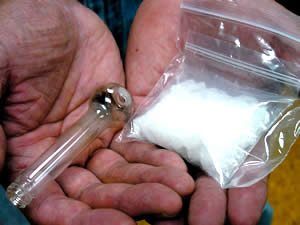Meth, speed, Tina, dope, go, etc increases arousal in the central nervous system by pumping up levels of two neurotransmitters, norepinephrine and dopamine. When taken at low doses, it boosts alertness while blocking hunger and fatigue. At higher doses, it causes exhilaration and euphoria. At very high doses, meth can cause agitation, paranoia, and bizarre behavior. Physical effects include increased heart rate, high blood pressure, and elevated body temperature.
 Widely available in the 1960’s, meth faded in the ’70s, as controls were tightened on legal production, which reduced its diversion onto the black market. But in the early ’90s, meth made a huge comeback. Since then its popularity has been rising and it is currently the most widely abused deadly drug used.
Widely available in the 1960’s, meth faded in the ’70s, as controls were tightened on legal production, which reduced its diversion onto the black market. But in the early ’90s, meth made a huge comeback. Since then its popularity has been rising and it is currently the most widely abused deadly drug used.
Risks of using meth are so extreme because the drug works so well at over-loading the central nervous system and zapping feelings of hunger and fatigue. Meth users take the drug for days and sometimes weeks on end without food or rest, putting impossible demands on their bodies and brains. For needle users, there are the added hazards that come with injecting any drug. And for meth smokers, multiply it all by the still largely-unknown risk factor of exposing lung tissue to vaporized meth crystals. Meth, more than any other drug pushes the mind and body faster and further than either was meant to go.
All across the United States meth addiction is running rampant. During 1999 4.3% (9.4 million people) of the U.S. population reported trying meth at least once in their lifetime. The highest rate of meth use was among adults ages 18-25. Although meth use is an epidemic across the United States, nowhere is it a bigger problem that in the Midwest. Meth accounts for nearly 90% of all drug cases in the Midwest, and is most prevalent in Oklahoma. In Oklahoma, meth is surpassing cocaine as the drug of choice. The state medical examiner’s office reports the number of death cases testing positive for meth have been higher than cocaine for the past three years. The office also reports meth is found in more and more cases of homicides, and motor vehicle accidents.
Psychological meth addiction is due to its tight hold on the individual’s pleasure center. As time goes by, meth begins to rule over the individual’s life, demanding attention at all times. This in turn leads them to resent circumstances when they are unable to use meth, such as with non-using friends, work, school, and family. As this resentment builds the individual will push others away who no longer “fit” into their desired lifestyle. No one wants to be a meth addict, but this doesn’t stop people from getting addicted.
